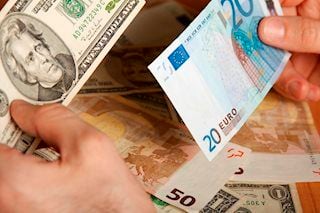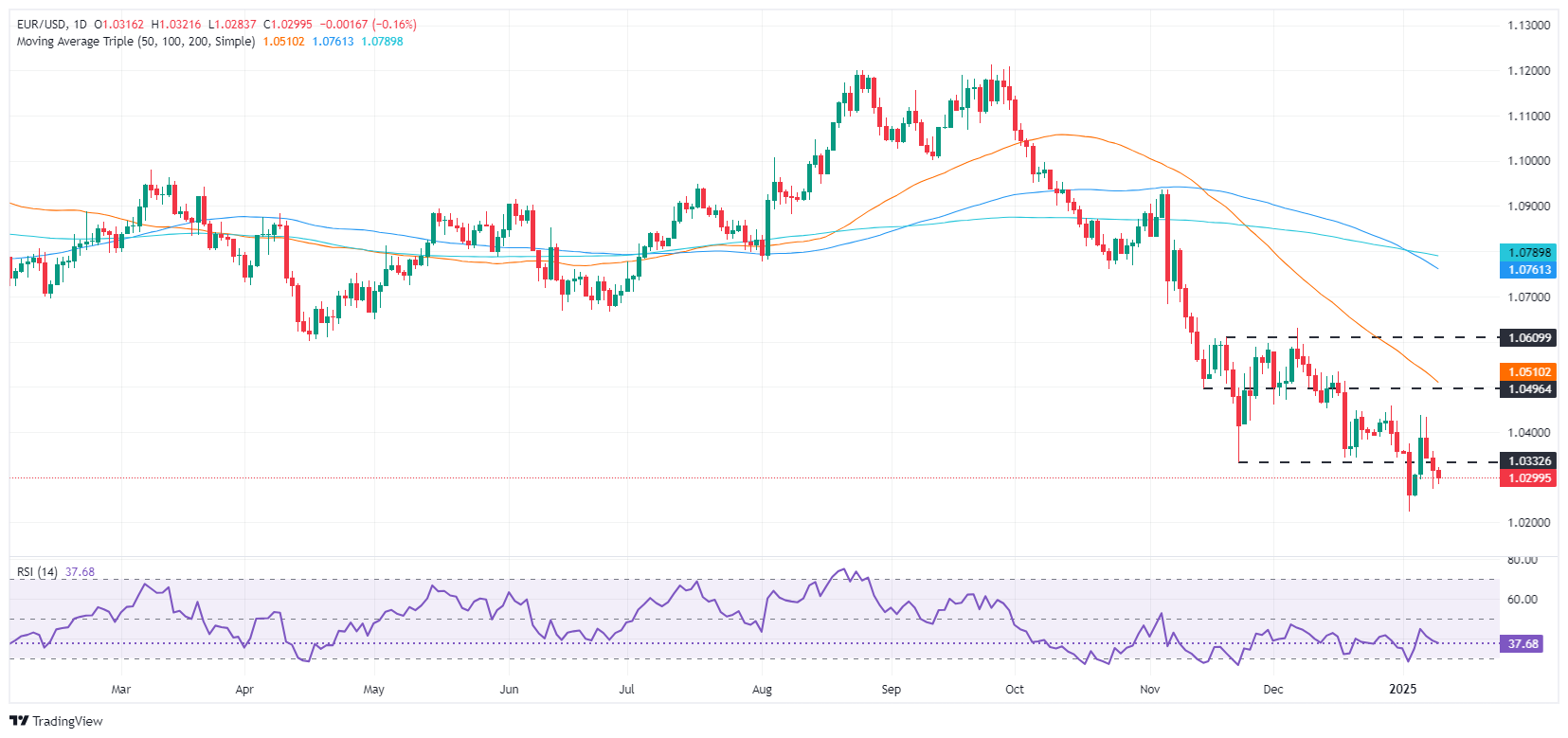EUR/USD Price Forecast: Subdued around 1.0300 ahead of US Nonfarm Payrolls
Premium|
You have reached your limit of 5 free articles for this month.
Get all exclusive analysis, access our analysis and get Gold and signals alerts
Elevate your trading Journey.
UPGRADE- EUR/USD marginally slides, resisting lower levels after three days of losses.
- Fed minutes suggest cautious, gradual rate cuts, noting upward inflation risks.
- Mixed US, Eurozone data: Germany's industrial output varies, Eurozone retail sales lag.
The EUR/USD pair hovers around familiar levels yet posted three days of losses yet clings to the 1.0300 figure unable to test the 1.02 handle. At the time of writing, the pair slides 0.14% as traders digest the latest round of data.
Euro clings to 1.0300 against a resurgent Dollar
The Greenback remains in the driver’s seat, propelled this time by the Federal Reserve’s latest meeting minutes. They showed that further rate cuts are needed if data comes as expected, though they would continue to move “gradually toward a more neutral stance.” Most favored the December 25 basis points cut, though they acknowledged that inflation risks are tilted to the upside.
The minutes revealed that officials see inflation heading towards its 2% goal. Yet, they stated, "The effects of potential changes in trade and immigration policy suggested that the process could take longer than previously anticipated."
Aside from this, a scarce economic docket featured the December US Challenger Jobs report, which revealed that employers laid off 38,792 fewer people than in November’s 57,727.
Federal Reserve officials put aside traders' boredom and crossed the newswires. Fed Governor Michelle Bowman maintained a hawkish stance, saying the central bank should be cautious in adjusting interest rates. At the same time, Kansas City Fed Jeffrey Schmid added that rates are “near” neutral.
Earlier, Philadelphia Fed Patrick Harker revealed that the US central bank could pause amid uncertainty, while Boston Fed Susan Collins said the current outlook suggests a gradual approach to rate cuts.
Across the pond, Germany’s November Industrial Production improved to 1.5% MoM but plunged 2.8% YoY. The Eurozone (EU) revealed that Retail Sales came at 0.1% in November, missing estimates for a 0.4% gain.
Given the backdrop, the US Dollar Index (DXY) rose by 0.16% up at 109.14. Market participants are expecting a less dovish Fed. The December 2025 Fed funds rate futures contract suggests the Fed could cut rates by 56 basis points (bps) towards the end of the year.
EUR/USD Technical Analysis
The EUR/USD daily chart indicates that the downtrend has paused after forming a 'tweezers top' pattern. Nevertheless, sellers could not exert pressure below 1.0300, allowing the pair to consolidate between 1.0300 and 1.0350. A drop below 1.0300 would expose initial support at 1.0272, with further downside targeting the January 2 swing low of 1.0222.
Conversely, if buyers reclaim 1.0350, and that might pave the way for a test of 1.0400.
Euro FAQs
The Euro is the currency for the 19 European Union countries that belong to the Eurozone. It is the second most heavily traded currency in the world behind the US Dollar. In 2022, it accounted for 31% of all foreign exchange transactions, with an average daily turnover of over $2.2 trillion a day. EUR/USD is the most heavily traded currency pair in the world, accounting for an estimated 30% off all transactions, followed by EUR/JPY (4%), EUR/GBP (3%) and EUR/AUD (2%).
The European Central Bank (ECB) in Frankfurt, Germany, is the reserve bank for the Eurozone. The ECB sets interest rates and manages monetary policy. The ECB’s primary mandate is to maintain price stability, which means either controlling inflation or stimulating growth. Its primary tool is the raising or lowering of interest rates. Relatively high interest rates – or the expectation of higher rates – will usually benefit the Euro and vice versa. The ECB Governing Council makes monetary policy decisions at meetings held eight times a year. Decisions are made by heads of the Eurozone national banks and six permanent members, including the President of the ECB, Christine Lagarde.
Eurozone inflation data, measured by the Harmonized Index of Consumer Prices (HICP), is an important econometric for the Euro. If inflation rises more than expected, especially if above the ECB’s 2% target, it obliges the ECB to raise interest rates to bring it back under control. Relatively high interest rates compared to its counterparts will usually benefit the Euro, as it makes the region more attractive as a place for global investors to park their money.
Data releases gauge the health of the economy and can impact on the Euro. Indicators such as GDP, Manufacturing and Services PMIs, employment, and consumer sentiment surveys can all influence the direction of the single currency. A strong economy is good for the Euro. Not only does it attract more foreign investment but it may encourage the ECB to put up interest rates, which will directly strengthen the Euro. Otherwise, if economic data is weak, the Euro is likely to fall. Economic data for the four largest economies in the euro area (Germany, France, Italy and Spain) are especially significant, as they account for 75% of the Eurozone’s economy.
Another significant data release for the Euro is the Trade Balance. This indicator measures the difference between what a country earns from its exports and what it spends on imports over a given period. If a country produces highly sought after exports then its currency will gain in value purely from the extra demand created from foreign buyers seeking to purchase these goods. Therefore, a positive net Trade Balance strengthens a currency and vice versa for a negative balance.
- EUR/USD marginally slides, resisting lower levels after three days of losses.
- Fed minutes suggest cautious, gradual rate cuts, noting upward inflation risks.
- Mixed US, Eurozone data: Germany's industrial output varies, Eurozone retail sales lag.
The EUR/USD pair hovers around familiar levels yet posted three days of losses yet clings to the 1.0300 figure unable to test the 1.02 handle. At the time of writing, the pair slides 0.14% as traders digest the latest round of data.
Euro clings to 1.0300 against a resurgent Dollar
The Greenback remains in the driver’s seat, propelled this time by the Federal Reserve’s latest meeting minutes. They showed that further rate cuts are needed if data comes as expected, though they would continue to move “gradually toward a more neutral stance.” Most favored the December 25 basis points cut, though they acknowledged that inflation risks are tilted to the upside.
The minutes revealed that officials see inflation heading towards its 2% goal. Yet, they stated, "The effects of potential changes in trade and immigration policy suggested that the process could take longer than previously anticipated."
Aside from this, a scarce economic docket featured the December US Challenger Jobs report, which revealed that employers laid off 38,792 fewer people than in November’s 57,727.
Federal Reserve officials put aside traders' boredom and crossed the newswires. Fed Governor Michelle Bowman maintained a hawkish stance, saying the central bank should be cautious in adjusting interest rates. At the same time, Kansas City Fed Jeffrey Schmid added that rates are “near” neutral.
Earlier, Philadelphia Fed Patrick Harker revealed that the US central bank could pause amid uncertainty, while Boston Fed Susan Collins said the current outlook suggests a gradual approach to rate cuts.
Across the pond, Germany’s November Industrial Production improved to 1.5% MoM but plunged 2.8% YoY. The Eurozone (EU) revealed that Retail Sales came at 0.1% in November, missing estimates for a 0.4% gain.
Given the backdrop, the US Dollar Index (DXY) rose by 0.16% up at 109.14. Market participants are expecting a less dovish Fed. The December 2025 Fed funds rate futures contract suggests the Fed could cut rates by 56 basis points (bps) towards the end of the year.
EUR/USD Technical Analysis
The EUR/USD daily chart indicates that the downtrend has paused after forming a 'tweezers top' pattern. Nevertheless, sellers could not exert pressure below 1.0300, allowing the pair to consolidate between 1.0300 and 1.0350. A drop below 1.0300 would expose initial support at 1.0272, with further downside targeting the January 2 swing low of 1.0222.
Conversely, if buyers reclaim 1.0350, and that might pave the way for a test of 1.0400.
Euro FAQs
The Euro is the currency for the 19 European Union countries that belong to the Eurozone. It is the second most heavily traded currency in the world behind the US Dollar. In 2022, it accounted for 31% of all foreign exchange transactions, with an average daily turnover of over $2.2 trillion a day. EUR/USD is the most heavily traded currency pair in the world, accounting for an estimated 30% off all transactions, followed by EUR/JPY (4%), EUR/GBP (3%) and EUR/AUD (2%).
The European Central Bank (ECB) in Frankfurt, Germany, is the reserve bank for the Eurozone. The ECB sets interest rates and manages monetary policy. The ECB’s primary mandate is to maintain price stability, which means either controlling inflation or stimulating growth. Its primary tool is the raising or lowering of interest rates. Relatively high interest rates – or the expectation of higher rates – will usually benefit the Euro and vice versa. The ECB Governing Council makes monetary policy decisions at meetings held eight times a year. Decisions are made by heads of the Eurozone national banks and six permanent members, including the President of the ECB, Christine Lagarde.
Eurozone inflation data, measured by the Harmonized Index of Consumer Prices (HICP), is an important econometric for the Euro. If inflation rises more than expected, especially if above the ECB’s 2% target, it obliges the ECB to raise interest rates to bring it back under control. Relatively high interest rates compared to its counterparts will usually benefit the Euro, as it makes the region more attractive as a place for global investors to park their money.
Data releases gauge the health of the economy and can impact on the Euro. Indicators such as GDP, Manufacturing and Services PMIs, employment, and consumer sentiment surveys can all influence the direction of the single currency. A strong economy is good for the Euro. Not only does it attract more foreign investment but it may encourage the ECB to put up interest rates, which will directly strengthen the Euro. Otherwise, if economic data is weak, the Euro is likely to fall. Economic data for the four largest economies in the euro area (Germany, France, Italy and Spain) are especially significant, as they account for 75% of the Eurozone’s economy.
Another significant data release for the Euro is the Trade Balance. This indicator measures the difference between what a country earns from its exports and what it spends on imports over a given period. If a country produces highly sought after exports then its currency will gain in value purely from the extra demand created from foreign buyers seeking to purchase these goods. Therefore, a positive net Trade Balance strengthens a currency and vice versa for a negative balance.
Information on these pages contains forward-looking statements that involve risks and uncertainties. Markets and instruments profiled on this page are for informational purposes only and should not in any way come across as a recommendation to buy or sell in these assets. You should do your own thorough research before making any investment decisions. FXStreet does not in any way guarantee that this information is free from mistakes, errors, or material misstatements. It also does not guarantee that this information is of a timely nature. Investing in Open Markets involves a great deal of risk, including the loss of all or a portion of your investment, as well as emotional distress. All risks, losses and costs associated with investing, including total loss of principal, are your responsibility. The views and opinions expressed in this article are those of the authors and do not necessarily reflect the official policy or position of FXStreet nor its advertisers.
